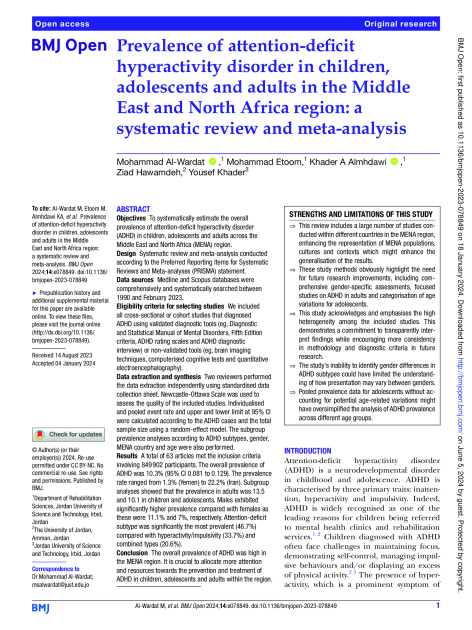Prevalence of attention-deficit hyperactivity disorder in children, adolescents and adults in the Middle East and North Africa region: a systematic review and meta-analysis

- Mohammad Al-Wardat
- Mohammad Etoom
- Khader A Almhdawi
- Ziad Hawamdeh
- Yousef Khader
BMJ Open
10.1136/bmjopen-2023-078849Abstract
Objectives: To systematically estimate the overall prevalence of attention-deficit hyperactivity disorder (ADHD) in children, adolescents and adults across the Middle East and North Africa (MENA) region.
Design: Systematic review and meta-analysis conducted according to the Preferred Reporting Items for Systematic Reviews and Meta-analyses (PRISMA) statement.
Data sources: Medline and Scopus databases were comprehensively and systematically searched between 1990 and February 2023.
Eligibility criteria for selecting studies: We included all cross-sectional or cohort studies that diagnosed ADHD using validated diagnostic tools (eg, Diagnostic and Statistical Manual of Mental Disorders, Fifth Edition criteria, ADHD rating scales and ADHD diagnostic interview) or non-validated tools (eg, brain imaging techniques, computerised cognitive tests and quantitative electroencephalography).
Data extraction and synthesis: Two reviewers performed the data extraction independently using standardised data collection sheet. Newcastle-Ottawa Scale was used to assess the quality of the included studies. Individualised and pooled event rate and upper and lower limit at 95% CI were calculated according to the ADHD cases and the total sample size using a random-effect model. The subgroup prevalence analyses according to ADHD subtypes, gender, MENA country and age were also performed.
Results: A total of 63 articles met the inclusion criteria involving 849 902 participants. The overall prevalence of ADHD was 10.3% (95% CI 0.081 to 0.129). The prevalence rate ranged from 1.3% (Yemen) to 22.2% (Iran). Subgroup analyses showed that the prevalence in adults was 13.5 and 10.1 in children and adolescents. Males exhibited significantly higher prevalence compared with females as these were 11.1% and 7%, respectively. Attention-deficit subtype was significantly the most prevalent (46.7%) compared with hyperactivity/impulsivity (33.7%) and combined types (20.6%).
Conclusion: The overall prevalence of ADHD was high in the MENA region. It is crucial to allocate more attention and resources towards the prevention and treatment of ADHD in children, adolescents and adults within the region.
Keywords
ADHD, prevalence, review, adolescent, adult neurology, adult psychiatry, mental health, public healthCitation
Al-Wardat, M., Etoom, M., Almhdawi, K.A., Hawamdeh, Z., & Khader, Y. (). Prevalence of attention-deficit hyperactivity disorder in children, adolescents and adults in the Middle East and North Africa region: a systematic review and meta-analysis. BMJ Open, 14(1), e078849, doi: 10.1136/bmjopen-2023-078849
Link to this page: https://res.adhd.org.sa/doi/10.1136/bmjopen-2023-078849